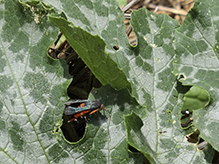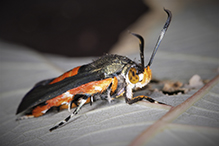squash vine borer
(Melittia cucurbitae)
Conservation • Description • Habitat • Ecology • Distribution • Taxonomy
|
||||||||
| Hodges # | 2536 |
|||||||
Conservation Status |
||||||||
| IUCN Red List | not listed |
|||||||
| NatureServe | NNR - Unranked |
|||||||
| Minnesota | not listed |
|||||||
Description |
||
Squash vine borer is a colorful, wasp mimicking, clearwing moth. It occurs in the eastern half of the United States, in southern Mexico, and in southern Ontario and Quebec, Canada. In Minnesota it is restricted to the southern half of the state. It is a serious agricultural pest of gourd (family Cucurbitaceae) crops, especially zucchini and Hubbard-type squashes. Adults are ⅝″ (17 mm) long and have a wingspan of 1⅛″ to 1¼″ (28 to 32 mm). They are said to resemble a wasp but do not have a constricted waist and have very different antennae. The pair of small, finger-like processes (labial palps) curving up from the lower part of the head are long, extending well beyond the middle of the face. The antennae are black with an irregular white streak above in the outer (distal) half. The forewings are long, narrow, rounded at the tip, black, and fringed with olive-green. The hindwings are much broader and have a large area that is transparent, completely free of scales. The rear margin of the forewing and the front margin of the hindwing each have a row of interlocking spines. The thorax is dark gray. The abdomen is mostly dull orange except for the first two segments, which are entirely dark olive green. There is a large, squarish, black dot at the front margin in the middle (middorsal) of segments 4, 5, 6 and 7. The legs are mostly black with narrow white bands. The third segment (femur) of the front legs is orange on the upper side. On the middle and hind legs, the femur has a dense fringe of long orange hairs, and the fourth segment (tibia) has a dense fringe of long black hairs. The larvae are white and have a brown head. They are rarely seen outside of the vine. |
||
Size |
||
Total length: ⅝″ (17 mm) Wingspan: 1⅛″ to 1¼″ (28 to 32 mm) |
||
Similar Species |
||
Habitat |
||
|
||
Ecology |
||
Season |
||
One generation per year. Mid-June to August |
||
Behavior |
||
Adults are active during the day and rest at night. |
||
Life Cycle |
||
The female deposits eggs singly on stems and leaves of host plants. The egg hatches in 10 to 15 days and the larva immediately bores into the vine. About four weeks later, the mature larva drops off the plant and burrows into the soil. The larva overwinters in the soil. It pupates in the spring and an adult emerges in mid-to late June. |
||
Larva Hosts |
||
Vines of plants in the gourd family (Cucurbitaceae), especially zucchini and Hubbard-type squashes, but also acorn and butternut squashes, gourds, and pumpkin. |
||
Adult Food |
||
Flower nectar |
||
Distribution |
||||
|
Sources |
|||
| 8/2/2022 | ||||
Occurrence |
||||
|
||||
Taxonomy |
|||
Order |
Lepidoptera (Butterflies and Moths) | ||
Superfamily |
Sesioidea (carpenter, leopard, goat, and allied moths) | ||
Family |
Sesiidae (clearwing moths) | ||
Subfamily |
Sesiinae | ||
Tribe |
Melittiini | ||
Genus |
Melittia | ||
Synonyms |
|||
|
|||
Common Names |
|||
squash vine borer (larva) squash vine borer moth (adult) |
|||
Glossary
Femur
On insects and arachnids, the third, largest, most robust segment of the leg, coming immediately before the tibia. On humans, the thigh bone.
Palp
Short for pedipalp`. A segmented, finger-like process of an arthropod; one is attached to each maxilla and two are attached to the labium. They function as sense organs in spiders and insects, and as weapons in scorpions. Plural: palpi or palps.
Tibia
The fourth segment of an insect leg, after the femur and before the tarsus (foot). The fifth segment of a spider leg or palp. Plural: tibiae.
Visitor Photos |
|||||
Share your photo of this insect. |
|||||
| This button not working for you? Simply email us at info@MinnesotaSeasons.com. Attach one or more photos and, if you like, a caption. |
|||||
Nanc |
|||||
Found on my Zucchini plants. |
|||||
 |
 |
||||
 |
|||||
Alfredo Colon |
|||||
 |
 |
||||
 |
 |
||||
 |
|||||
Strange Moth |
|||||
 |
 |
||||
 |
|||||
It is a beauty ! |
|||||
 |
 |
||||
MinnesotaSeasons.com Photos |
|||||
|
|||||

Slideshows |
||

Visitor Videos |
|||
Share your video of this mammal. |
|||
| This button not working for you? Simply email us at info@MinnesotaSeasons.com. Attach a video, a YouTube link, or a cloud storage link. |
|||
Other Videos |
|||
| Squash Vine Borer Nectaring (Melittia cucurbitae) Mona Miller |
|||
About
Jul 8, 2015 Hobbyists are welcome to learn more about creating habitat and rearing butterflies and moths, please join our conservation group: https://www.facebook.com/groups/butterflyandmothconservation/ |
|||
| Squash Vine Borer Moth (Melittia cucurbitae) ProjectHEALCreekRun |
|||
About
Jun 18, 2012 This is a squash vine borer moth visiting some milkweed in our garden. Its movement and color mimic a wasp or bee. |
|||


Created: 2/1/2020
Last Updated:



